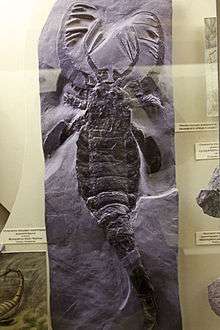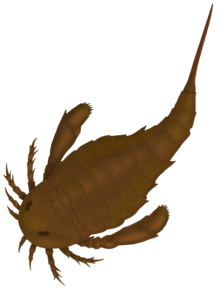Carcinosomatoidea
Carcinosomatoidea is an extinct superfamily of eurypterids, an extinct group of chelicerate arthropods commonly known as "sea scorpions". It is one of the superfamilies classified as part of the suborder Eurypterina.
| Carcinosomatoidea | |
|---|---|
 | |
| Fossil of Mixopterus kiaeri exhibited at the Moscow Paleontological Museum. | |
| Scientific classification | |
| Kingdom: | Animalia |
| Phylum: | Arthropoda |
| Subphylum: | Chelicerata |
| Order: | †Eurypterida |
| Infraorder: | †Diploperculata |
| Superfamily: | †Carcinosomatoidea Størmer, 1934 |
| Families | |
| Synonyms | |
| |
Some carcinosomatoid genera have been suggested to have been fully marine as opposed to living in near-shore brackish or hypersaline environments.[2]
The majority of carcinosomatoid taxa are known from the paleocontinents of Laurentia, Baltica and Avalonia. Isolated and fragmentary fossils from the Late Silurian of Vietnam and the Czech Republic show that the terranes of Annamia and Perunica were within the geographical range of the carcinosomatoids. Only a few basal carcinosomatoids (e.g. Carcinosoma and Paracarcinosoma) have been found in deeper waters whilst the more derived forms, such as Mixopterus and Lanarkopterus have not. Basal carcinosomatoids (Carcinosomatidae) are likely responsible for the fossil remains in Vietnam and the Czech Republic and may have had a distribution similar to the cosmopolitan distribution of the pterygotoids, though were not as common nor as successful.[2]
Classification
The Carcinosomatoidea have a poorly resolved internal phylogeny, though can be easily recognised by scorpion-like appearance and heavily spinose appendages. Numerous characteristics support a close relationship to the Eurypteroidea.[2]
References
- Lamsdell, James C.; Briggs, Derek E. G.; Liu, Huaibao; Witzke, Brian J.; McKay, Robert M. (September 1, 2015). "The oldest described eurypterid: a giant Middle Ordovician (Darriwilian) megalograptid from the Winneshiek Lagerstätte of Iowa". BMC Evolutionary Biology. 15: 169. doi:10.1186/s12862-015-0443-9. PMC 4556007. PMID 26324341. Retrieved September 1, 2015.
- O. Erik Tetlie (2007). "Distribution and dispersal history of Eurypterida (Chelicerata)" (PDF). Palaeogeography, Palaeoclimatology, Palaeoecology. 252 (3–4): 557–574. doi:10.1016/j.palaeo.2007.05.011. Archived from the original (PDF) on 2011-07-18.
